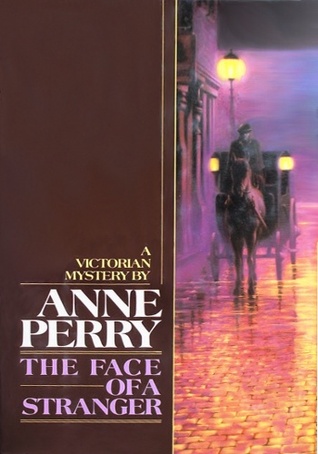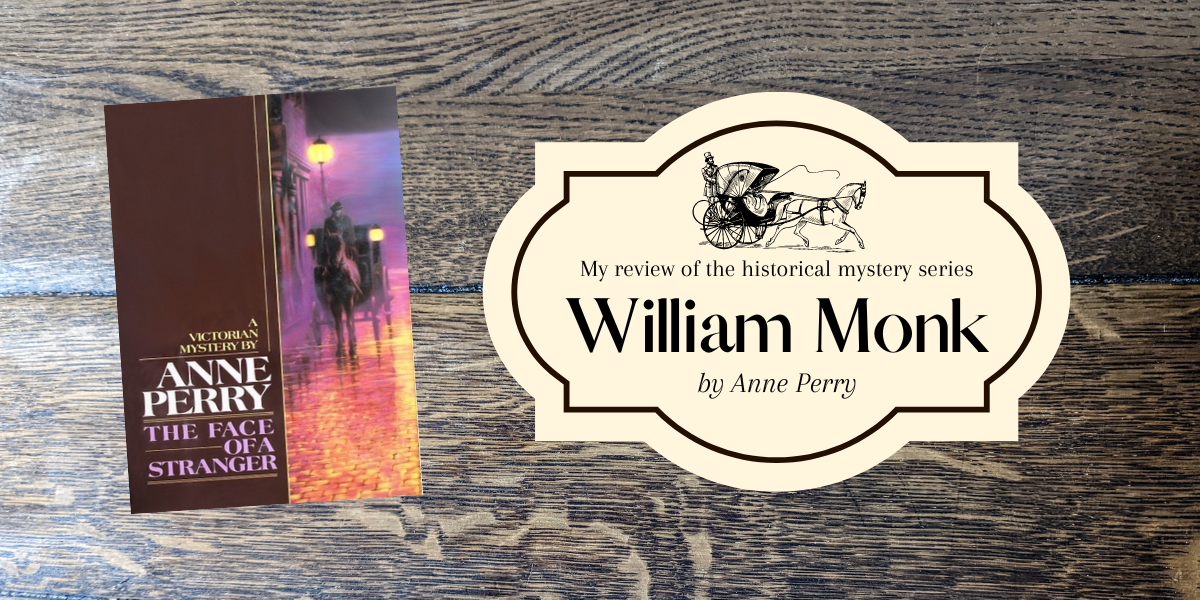Review of William Monk by Anne Perry. The first book in historical fiction series, the William Monk, is called The Face of a Stranger and is set in London in the 1856.
The William Monk stories are very much driven by the protagonists and the view into the time. It is like time traveling with very interesting guides and being dropped into a murder mystery. I give all of the books either five or four stars depending on the story. I think I liked the first books best but it is often so in a series. Each story is self contained but they are set on a timeline and they grow as people and their relationships do develop over time. This is not an old fashion tv-show where everything has to go back to status quo at the end of the book.
My review of The Face of a Stranger by Anne Perry
What a truly enjoyable read! What a truly extraordinarily well told story! I felt like being in London in the 1850s – transported back in time.
The Face of a Stranger kept me up till late in the evening and gave me excesses to sit and listen – sometimes I was so wrapped up in it that I didn’t even want to do anything while I listened. And I often wished I had the paper version so I could bring it to bed.

My review from 2013 of William Monk by Anne Perry
Title: The Face of a Stranger
Author: Anne Perry
Series: William Monk, book 1-7
Genre: Historical fiction, mystery
Themes:
have read the first seven books in the William Monk series. I read the first ones as audiobook but at some point there was a gap in the books Audible offered at least in Denmark so I ordered the next books as used paperbacks from Amazon. I just got around to reading these. As I am on a 1800s historical inspired fiction run I thought these would fit right in.
The Face of a Stranger
The first book, The Face of a Stranger, take place in 1856 where our main protagonist William Monk has lost his memory in a traffic accident (like in Parasite). The first book is about him discovering who he was and trying to come to terms with who he is now and how the two people are and are not the same person. We are all different from who we were in the past but it is more acute with a amnesia scenario and it offers an excellent opportunity to explore what makes up our identity. Which is apparently a theme I am attracted to right now.
Historical mystery novels
The rest of the series is more straight historical mysteries than the first book. They are all page turners and tend to keep me up past my bedtime. It is rarely the mystery that drives me to keep reading but the enjoyable interplay between the characters and the vivid characterisation of the 1850s London.
The protagonists: William, Hester and Oliver – the investigator, the nurse and the barrister
In the first book William Monk is very much the main character. As the series progresses two more characters are also protagonists in as much their own right as Monk is – sometimes more so. Monk starts out as a police investigator and becomes a private investigator.
Our other protagonists are Hester Latterly who was a nurse in the Crimean War and is quite a capable lady high birth. Oliver Rathbone who is a defence attorney. They are all highly intelligent people and not of them have easy temperaments which makes for witty dialog. Common for all of them is their hatred for injustices, which is what brought them together and bind them together. Their interplay is always funny to watch and they have lovely complicated relationships. To make their relationships more complicated they work for each other in different configurations in the different books.
History: Politics, social & gender issues
Social & gender issues and politics plays a big part of the books, both as plot points and more generally as backdrop for the stories. Hester find the traditional roles of women of breeding unbearable and has chosen to step outside the role and take up one of the few professions open to women, nursing. She quite often goes undercover and gathers information to help solve the plots. Hester is quite brave to the point of being a bit reckless at times. When we follow her point of view the roles of women tend to commented on and noticed as part of the storytelling.
Monk however notice social injustices acutely and his work does tend to take him into the underbelly of London. Oliver Rathbone travels in the higher layers of the English society without being part of the upper class as such. His work also puts him in direct contact with the English judicial system, which is at the time quite harsh. In more than one case they are trying to save someone from hanging. Anne Perry does not shy away from the darker side of the times. She shows us the beautiful gilded halls of the upper class in one chapter and in the next takes us into the worst slum of London in the middle of an epidemic.
London plays a big part of these books to the point where it is almost a fourth character, which is how I like books placed in the real world best. I love it when there is a strong sense of place in a book.
The descriptions tend to be quite detailed to the point where you can almost smell the streets of London. It can bug the story down a bit at times but I think it is also part of the charm.
The books are also really well researched so it is possible to read them as a history fan which out stumbling over anachronisms all the time. English 1800s history is not my specialty but I have not stumbled over anything I thought seemed out of place, which I really appreciate. If I had read these as kindle books I am sure I would have been looking up things left, right and center because I like to do research while reading. But as it was I now know about the Crimean War, nursing in the 1800s and the British judicial system which I did not know a thing about when I started reading.



Upstairs and downstairs
In general the series takes us both upstairs and downstairs and out on the street. We meet the cabby, the street urchin and the hooker as well as the artisan, the doctor, the dandy and the gentleman. The supporting cast is as likely to be men as women. I have not noticed many people of colour but it is quite likely that they have just not stood out in the way they were described. There are not many non-strait characters but I do think that is a matter of it being so socially unacceptable that it would not be known to our point of view characters if they were, unless it was the focus of one of the many scandals in the books.
The mysteries and story
The mysteries are really interesting and complicated enough to keep me guessing without falling into Agatha Christie territory where the reader has no chance of figuring out what is going on. Some of the mysteries relies on physical evidence, others undercover work, others lots of interviews and others again are court room dramas. Not all of the books are murder mysteries, though that does tend to be the case. Perry uses each mystery to take us into a part of English society that we have yet to visit. Real historical events are often the backdrop of the story but rarely steps into centre stage. The same goes for historical figures who we meet but does not interact with at length – they are more like camioes.
Currently I am reading Weighed in the Balance, which has a disabled young man who is coming to terms with being disabled as one of the supporting cast. In the fiction I am reading that is a really unusual theme to deal with. And it is dealt with in a quite compassionate and matter of fact way, that is really nice to see. I just finished Weighed In the Balance and I have to say that I was almost unable to put it down the last 30 % of the book. I am now reading The Silent Cry which have me guessing. It is definitely one of the better ones in the series.
The William Monk series is very much driven by the protagonists and the view into the time. It is like time traveling with very interesting guides and being dropped into a murder mystery. I give all of the books either five or four stars depending on the story. I think I liked the first books best but it is often so in a series. Each story is self contained but they are set on a timeline and they grow as people and their relationships do develop over time. This is not an old fashion tv-show where everything has to go back to status quo at the end of the book.
The stats: William Monk series
Published: 1990 to 2013 by Fawcett
Read: 2012-2013
This review was originally posted: January 17 2012 & November 16, 2013. Updated and edited July 2, 2023


Leave a Reply